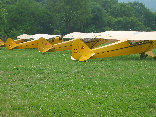I began a search for every Piper Cub I could find within driving distance. I was curious how they looked and how they were put together. I learned from John that “restored” could mean anything from an exact restoration of the particular model as it rolled out of the factory to a multiplicity of variants. But like automobiles, planes came out of the factory with variations in engines, instruments, and amenities. And often later changes were required by the FAA for safety reasons. The best example is the transition from grade A cotton fabric to Dacron
Ted's Aircraft Shop
Step 2. Organizing and Planning, page 3
Step 2. Organizing and Planning
—Ceconite or its many variants—and a change in coatings from the highly-flammable nitrate dope to the less-flammable butyrate
dope. Sensitive altimeters, with adjustments for barometric pressure, replaced simpler models. Sealed struts replaced
the older unsealed struts with fewer corrosion problems. Other changes are less evident to the casual observer but make a big
difference in performance. A larger skylight, introduced on the PA-18 Super Cub, became a popular change on the J-3. The
increasingly scarce Continental A-65 engine, mated to most J-3s after the war, is often replaced by the C-85 or the O-200. Roughly
speaking, the crankcase of these three engines is essentially the
same, so the appearance is little changed. Many of the changes in “restorations” are virtually invisible
despite their utility, and I decided to take advantage of many of these changes. The original fuel tank is a 12 gallon tank
in front of the instrument panel. I decided to put in an additional tank in the left wing with 8 gallons. From my experience
with the Aeronca, that extra fuel can mean stretching a flight for an hour or 100 miles, a big improvement when suitable airports
are farther apart. The original baggage compartment, literally only big enough for a couple of maps and the headphones, is often
replaced with a large baggage compartment, big enough for a couple of overnight bags and perhaps a couple of sleeping bags. That turns a fun day aircraft into a flying RV—a big improvement in the fun category. The larger baggage
had the original A-65 engine and the C-85 that had been installed when the plane crashed. He had boxes and boxes of individual
parts that had been recovered from the crashed plane. We quickly came to a deal. I bought the A-65 for $1500, the C-85
for $500 (for parts), and a carload of boxes of individual parts for $2818, mostly sight unseen. It was a gold mine for both
of us. He gained an unexpected $4818 and I had everything I needed for a complete plane. I passed on the bent propeller.
(Actually Don convinced himself he needed to make the prop into a clock or lamp.)


10. Covering the Fuselage
11. Assembling and Rigging
12. Flight Testing